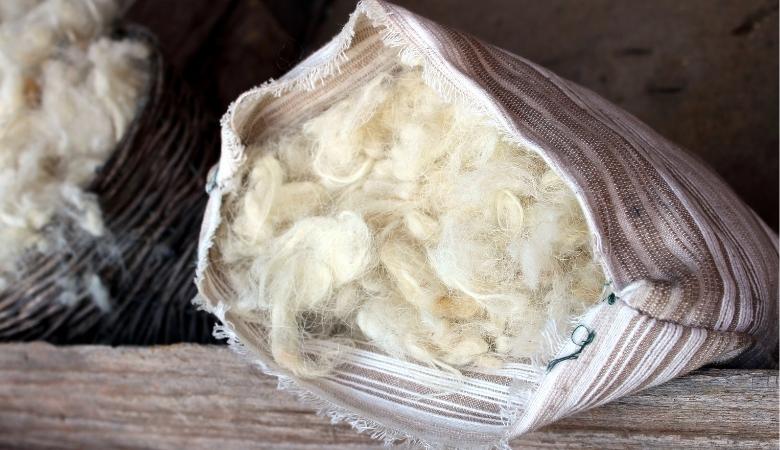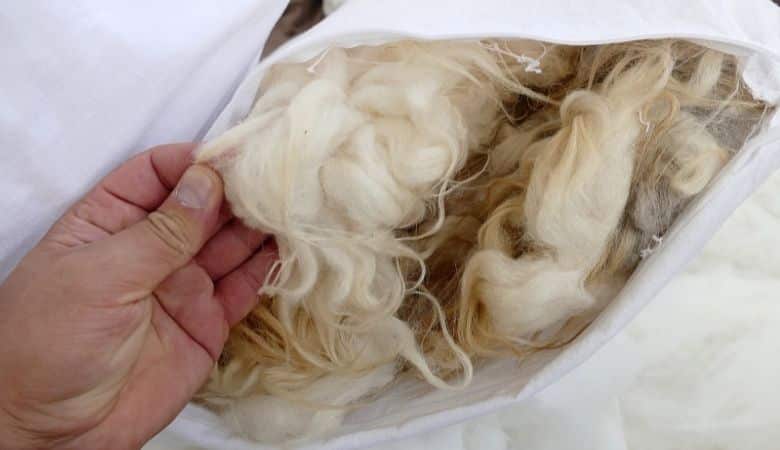This post is a part of the complete wool pillow buyers guide
Granted, a good night’s sleep has many benefits, including improving your mood and looking fabulous. While mattresses are usually praised for these benefits, the almost neglected pillow plays a significant role in ensuring you wake up happy and relaxed.
It’s safe to say that wool pillows were among the first in the world since sheep were domesticated at least 10,000 years ago. Although they aren’t the most popular option today.
Why Use a Wool Pillow?

Wool has been there for thousands of years. Thanks to its many wonderful features, it has been used extensively to make various products such as clothes, blankets, carpet rugs, insulation, and even upholstery.
Given its long, rich history, it comes as no surprise that wool would make pillows. What’s surprising, however, is that other filling materials like feathers and fiber are more popular.
Wool pillows feel like any regular pillow filled with polyester fiberfill. Because it’s similar to fiberfill, it’s not too moldable, so mashing it doesn’t change its shape. Despite its softness, it’s not as pliable as other natural pillow materials and tends to retain its shape. This is great news if you hate pillows that go flat, clumping up the more you sleep on them.
8 Great Benefits of Using A Wool Pillow
1. It is hypoallergenic
If you have allergies, shopping for bedding can be strenuous. It’s hard finding beddings that are hypoallergenic and bacteria resistant.
Wool is a natural, non-toxic material that is great if you react to even the smallest amounts of residues often left on synthetic pillows. Even though it might look clean, synthetic bedding has gone through various processes such as bleaching and treatment to make it flame and mold resistant.
Other than that, synthetic fiberfill can produce small amounts of formaldehyde and other chemicals that can cause health problems, and washing won’t completely remove them.
2. It is Breathable
Wool is very breathable, and it can insulate heat. It has a unique ability to absorb moisture and draw it from the skin, thus regulating the body’s overall temperature.
These moisture-wicking properties enhance natural airflow around your head, keeping you cool and dry as you sleep. Wool fibers are naturally adapted to controlling and maintaining a steady temperature, a great feature to add to pillows.
Reduced overheating and wetness means you are comfortable throughout the night and can have sounder sleep.
The thermal resistance or ability of a material to control temperature changes is measured in togs. This rating system is commonly found on beddings nowadays, and it can help you know how well a particular material will insulate you.
The structure of wool gives it a varying tog rating as it changes depending on the temperature. The warmer you are, the more heat is dispersed and vice versa; this is a great way to keep a steady temperature all night.
Another perk of wool’s breathability can also improve your skin’s appearance, helping reduce pillow acne, puffy eyes, and pressure lines on the face.
3. It Offers Temperature Regulation
Wool is twice as effective as cotton at moving moisture vapor through fabric and 10 times better than polyester.
Wool keeps you in the thermal comfort zone for much longer than most other pillows. It does this by keeping you cool in the summer and cozy in the winter to sleep well in all seasons.
4. It is Mold and Dust Mite Resistant

Unlike other pillow making materials, wool is mold and dust mite resistant. The microscopic bristles and lanolin of the wool fiber make it inhospitable to dust mites. Its ability to wick away moisture takes away an essential element of the life of dust mites.
House dust mites are an allergy trigger and are present all over your home. For most people, they cause no symptoms. If you have allergies, the allergens in these mites’ feces trigger a wide range of allergic reactions from sneezing to wheezing and even worsening eczema.
5. It is Comfortable
There’s a misconception that wool is rough, too hot, and itchy, making it a horrible choice for pillow fill. However, this isn’t true.
Wool has very fine fibers that create this lush, soft, lofty filling, great for pillows. It is also quite resilient and retains its shape over time, unlike other pillow fills that clump and lump up.
It also doesn’t lose its bounce and thus provides excellent back and neck support longer. Its natural crimped and coiled structure means that the wool fiber can be stretched out and bounce back to its form.
6. It is Eco-friendly
Wool is a natural material, obtained from the fleece of sheep. Sheep can grow a new coat of wool yearly; this means its renewable. Since it is natural, its biodegradable meaning it won’t pollute the environment. It also doesn’t require processing as other pillow fiber fills do.
This means no pesticides and other environment harming chemicals are used in the production of wool pillows. Wool is also pretty durable. It lasts longer and is more resilient than cotton and even latex.
7. It Offers Good Support
Wool pillows offer great support that’s good for people who sleep on their stomach, back sleepers, and side sleepers. That’s literally all sleepers, although most of us are side sleepers.
That is the support you don’t get from most other pillows, like a feather, synthetic, or down pillow.
8. It is Great For Toddlers
If you have small children and want to ensure their sleep experience is the best — free of allergens and other bacteria — you may want to invest in a wool pillow.
One of the best materials you can choose when buying pillows for your toddler or small child is organic and naturally grown wool. Wool is a completely organic and eco-friendly material, ensuring comfort and health for your child.
Most toddlers have sensitive skin; wool would be the perfect choice for them to sleep on.
6 Wool Pillow Drawbacks
While wool pillows are great for most people, they are not the best option for everyone. Not everyone would be quick to purchase a wool pillow, and here are the reasons why:
1. Higher Cost

Wool pillows offer a lot — they’re hypoallergenic, breathable, temperature regulated, and comfortable. That’s why you’ll find them in the luxury or premium pillow aisle of your favorite bedding store. That means they’re a little more expensive than most pillows.
2. Lack Conformity
Wool pillows often feel flat and dense. They don’t conform to the head, which means you may have to move around a bit or keep adjusting to get it in the most comfortable spot for your head. With that said, there are things you can do to soften up a wool pillow making it feel better.
3. Not The Best for Neck Pain
While wool pillows can easily be adjusted to the loft and fill you need, they may not be the best pillows for neck pain. If you suffer from back pain, don’t depend on a wool pillow to ease that pain.
4. Smelly
Compared to some pillows with a gassy smell, wool pillows are all-natural and contain no chemicals that create that off-gassing smell. However, the all-natural wool fabric is not the best to smell.
That can be problematic for some sleepers and may even keep them from sleeping if they’re light sleepers. Fortunately, the smell, as with pillows that off-gas, will fade away over time.
5. Challenging to Clean
It can be challenging to clean a wool pillow. They require careful handling and care. They can be machine-washed, but not like other pillows. It’s probably best to do a quick surface clean and use a pillow protector and a pillowcase.
A waterproof protector will disable the breathable benefits you naturally get from a wool pillow. However, it’s always best to refer to label instructions when it comes to caring for your wool pillow.
6. Itchiness
When many people think of wool, they think of a fabric that causes them to itch. They may even think they’re allergic to it. But wool allergies are rare.
The itchiness is likely an aversion to thick wool fibers. If this is you, you may not like the feel of wool.
How to Benefit the Most From Using a Wool Pillow

Every product has its good and bad qualities. While wool has some non-appealing qualities, most people would say wool performs well over time, better than most other bedding materials they’ve used.
If you decide to give wool a try, here are a few buying tips for your wool pillow:
- Filling: Make sure your wool pillow is made from pure yarn filling, not mixed with other filling material such as synthetic polyester. That can affect the quality of the pillow. You can know if it’s a 100% pure and organic wool pillow by checking the label.
- Size: Look for a size that can support your shoulder, so it will not put much stress and pressure on your shoulder. People with small body frames will need a low-profile cushion. If you have a medium frame, a medium-sized pillow will do. And lastly, a high-profile pillow is needed for people with larger body frames.
- Firmness: The level of firmness depends on your personal preferences, whether you want a soft or a firmer pillow. Since pure wool is naturally soft and smooth, this level of firmness is appropriate for people who sleep on their stomachs and those who sleep on their back. On the other hand, for people who prefer a firmer pillow, wool is usually blended with polyester to achieve the desired level of firmness, which is appropriate for side sleepers. That means when choosing the firmness level of wool pillows, you may also consider your sleeping position. That way, you can find the perfect pillow that supports your sleeping needs.
- Cost: Generally, wool pillows are expensive compared to other types of pillows. However, you can look for a cheaper alternative wool pillow by buying a wool pillow blended with synthetic materials, like polyester. Although 100% natural is recommended; only buy a blended pillow if being 100% all-natural is not a priority for you.
- Pillowcases/Coverings: Your pillow covering should be soft to the touch when you rub your face against the surface of the pillow. External covers that complement wool pillows are usually available in two varieties: cotton and silk. However, cotton is more common since it is naturally soft and durable.
Conclusion
As you have seen, wool makes great pillows because they are soft and quite comfortable and last a long time.
The benefits highlighted here are clear indicators of why wool is a great pillow fill, But as with all materials, it do has it’s drawbacks as well.
Overall (and for the right person), if you are looking for a pillow to help you sleep better, then wool is the way to go.
Wool Pillows: A Complete Buyers Guide – Parts:
1. Why Use a Wool Pillow? The Benefits & Drawbacks
2. Wool vs. Down Pillows: Similarities, Differences & Which to Choose
3. How Long Do Wool Pillows Last? This is The Replacement Time
4. Do Wool Pillows Sleep Hot or Cool? Or Both Depending on The Climate?
5. Why do Wool Pillows Get Lumpy? How to “Unlump” Them
6. How to Soften a Wool Pillow: Step by Step Guide
7. How to Wash And Dry a Wool Pillow: Step by Step Guide
8. Best Wool Pillows of 2022 – Complete Review
